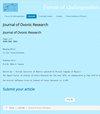Visible light photo catalytic and optical property evolution of combustion method prepared copper doped nickel ferrite nanoparticles
IF 1.1
4区 材料科学
Q4 MATERIALS SCIENCE, MULTIDISCIPLINARY
引用次数: 0
Abstract
By using a simple microwave combustion technique, copper-doped NiFe2O4 spinel nanoparticles were formed. The XRD patterns demonstrated that Cu doping into NiFe2O4 spinel resulted in the creation of α-Fe2O3 secondary phase in addition to the cubic structure that already existed. Using SEM, morphological investigations revealed irregular shapes and severely agglomerated different grain boundaries. In an optical analysis, it was discovered that the band gap narrowed as the Cu2+ doping percentage raised. The octahedral site (Ni-O) and tetrahedral site (Fe-O) stretching modes of the Cu-doped nanoparticle structure were linked to bands at 548, 514, and 649cm-1 from FT-IR analysis. Cu-doped nanoparticles were examined for their enhanced photocatalytic degradation of RhB in visible light irradiation under atmosphere condition. The performance of pure NiFe2O4 as a photocatalyst was discovered to be greatly impacted by the Cu-doping. Additionally, the photo-catalytic effect was optimized (efficiency rose from 88.26 percent, x = 0-99.85 percent, x = 0.4) with the rise of Cu-doping into x=0.4. An in-depth discussion was had on the potential photocatalytic mechanism. The simultaneous improvement of photocatalytic activities serves as proof that Cu-doped NiFe2O4 spinel nanoparticles will perform well in multifunctional photochromic devices in future.可见光光催化及燃烧法制备掺铜镍铁氧体纳米颗粒的光学性质演化
采用简单的微波燃烧技术制备了掺杂铜的NiFe2O4尖晶石纳米颗粒。XRD分析结果表明,在NiFe2O4尖晶石中掺杂Cu,在原有立方结构的基础上又生成了α-Fe2O3次级相。通过扫描电镜观察,形貌显示出不规则的形状和严重聚集的不同晶界。在光学分析中,发现带隙随着Cu2+掺杂百分比的增加而缩小。通过FT-IR分析,cu掺杂纳米颗粒结构的八面体位点(Ni-O)和四面体位点(Fe-O)的拉伸模式与548、514和649cm-1的波段相连。研究了cu掺杂纳米粒子在可见光环境下对RhB的光催化降解效果。发现纯NiFe2O4作为光催化剂的性能受cu掺杂的影响很大。此外,随着cu掺杂量增加到x=0.4,光催化效率从88.26% (x=0 ~ 99.85%, x=0.4)得到优化。并对潜在的光催化机理进行了深入讨论。光催化活性的提高证明了cu掺杂NiFe2O4尖晶石纳米颗粒在多功能光致变色器件中具有良好的应用前景。
本文章由计算机程序翻译,如有差异,请以英文原文为准。
求助全文
约1分钟内获得全文
求助全文
来源期刊

Journal of Ovonic Research
MATERIALS SCIENCE, MULTIDISCIPLINARY-PHYSICS, APPLIED
CiteScore
1.90
自引率
20.00%
发文量
77
期刊介绍:
Journal of Ovonic Research (JOR) appears with six issues per year and is open to the reviews, papers, short communications and breakings news inserted as Short Notes, in the field of ovonic (mainly chalcogenide) materials for memories, smart materials based on ovonic materials (combinations of various elements including chalcogenides), materials with nano-structures based on various alloys, as well as semiconducting materials and alloys based on amorphous silicon, germanium, carbon in their various nanostructured forms, either simple or doped/alloyed with hydrogen, fluorine, chlorine and other elements of high interest for applications in electronics and optoelectronics. Papers on minerals with possible applications in electronics and optoelectronics are encouraged.
 求助内容:
求助内容: 应助结果提醒方式:
应助结果提醒方式:


